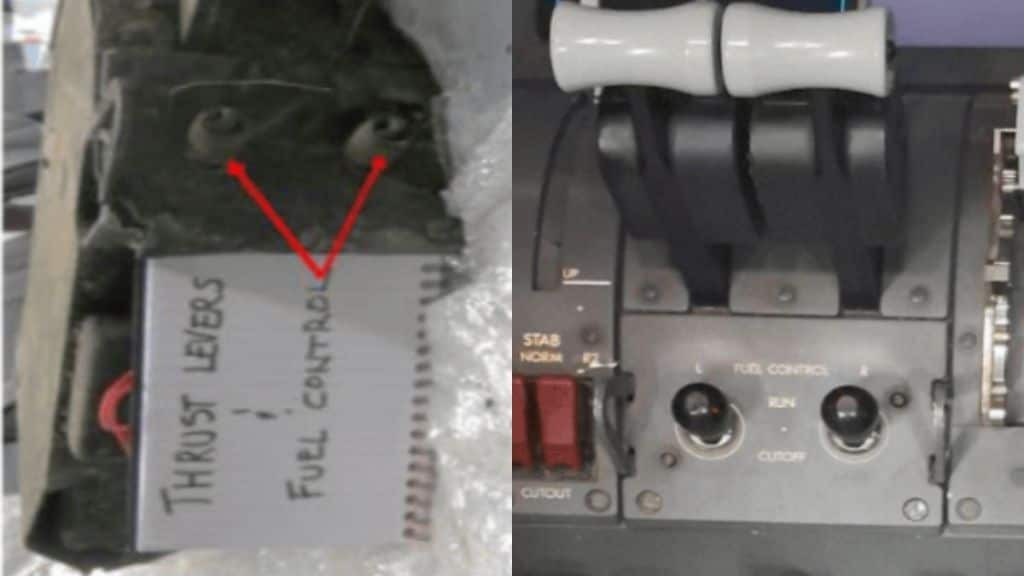Air India plane crash report: In one of the deadliest aviation disasters involving an Indian airline in over four decades, the preliminary findings from the Aircraft Accident Investigation Bureau (AAIB) on the Air India AI171 crash have shed light on what transpired in the cockpit of the ill-fated Boeing 787-8 Dreamliner. The flight, bound for London Gatwick from Ahmedabad, crashed shortly after takeoff on June 12, killing 260 people, including 241 passengers and crew and 19 on the ground.
According to the AAIB’s preliminary report, the aircraft lifted off at 08:08:39 GMT, and just three seconds later, both engine fuel cutoff switches flipped from RUN to CUTOFF, one after the other, a second apart. This unusual and critical transition effectively starved both engines of fuel, triggering a loss of thrust during the aircraft’s initial climb.
Shortly after, the aircraft began to lose altitude. CCTV footage captured a Ram Air Turbine (RAT) deploying, an emergency mechanism that activates when engine power is lost. While investigators have not found any evidence of fire or other damage at the time, the aircraft failed to regain altitude despite brief signs that the engines were attempting to relight.
Black box audio reveals cockpit confusion
Cockpit voice recordings obtained from the black box provide insight into the final moments. One pilot was heard asking, “Why did you cut off the fuel?”, to which the other replied, “I did not do so.” These chilling words suggest that neither pilot was aware of having manually moved the switches.
It remains unclear who made the “Mayday” distress call that followed, or which pilot made either of the comments. The black box captured 49 hours of flight data and two hours of cockpit conversation, a vital source for reconstructing the timeline of the disaster.
Timeline of the crash
Here are key moments from the preliminary report:
08:08:42 GMT: Aircraft reaches 180 knots. Fuel cutoff switches flip from RUN to CUTOFF.
08:08:47 GMT: Engines drop below idle. RAT begins hydraulic power supply.
08:08:52 GMT: Engine 1 switch is flipped back to RUN.
08:08:56 GMT: Engine 2 switch also flipped back to RUN.
08:09:05 GMT: “Mayday, Mayday, Mayday” call issued.
08:09:11 GMT: Data recording stops.
08:14:44 GMT: Rescue services dispatched.
Though the engines attempted to relight, it was too late. One engine showed signs of recovery, while the other failed to arrest its deceleration.
Could the switches flip accidentally?
Aviation experts are deeply concerned. According to US aviation safety analyst Anthony Brickhouse, a pilot accidentally flipping both switches almost simultaneously during takeoff is extremely unlikely. John Nance, another analyst, noted that cutoff switches are typically used only post-landing or in dire emergencies, such as an engine fire. However, no such emergency was reported in this case.
Adding to the mystery, the switches were found back in RUN position at the crash site, suggesting that the crew had attempted to correct the mistake before impact.
In a brief statement, Air India said it was “fully cooperating with authorities” and mourning the loss of lives, without commenting on the report’s specifics.
Boeing said it was supporting the investigation, while GE Aerospace, the engine manufacturer, has not yet responded.
The US Federal Aviation Administration (FAA) and National Transportation Safety Board (NTSB) are assisting in the investigation. The NTSB thanked Indian officials and noted that no immediate changes were recommended for Boeing 787s or GE engines.
Meanwhile, the EU Aviation Safety Agency is investigating Air India Express over past violations. The DGCA has also flagged Air India for multiple safety oversights.


